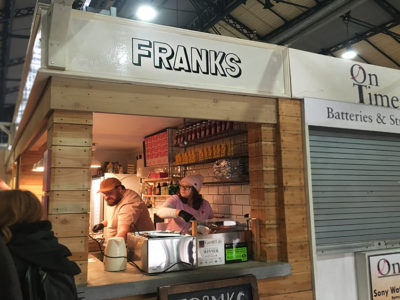Street Food Timeline: 1000 years of street food
Late 1000s – The origins of British street food when the Normans come to Britain.
1800s – The eight hundred year gap changes what vendors are selling – there is now a wider range of street food.
Early 1900s – It is seen as unfit to be seen eating in public. Food hygiene standards become more important, resulting in the decline of street stalls.
1970s – ‘Roach coaches’ start selling cheap food in America. They are discovered by American’s food writers and street food becomes fashionable.
Late 1900s – The farmers’ markets usher in the street food revolution in Britain, since people with more money grab a bite to eat while shopping.
2010 – The first British Street Food Awards are held, run by journalist Richard Johnson. Social media gives vendors a cheap and effective outlet to advertise themselves.

Bath Street Feast is held every Friday night from 5:30pm at Green Park Station (photo credit: Adelaide Newton)
The street is lined with stalls. Steam rises from each one, curling in the cold night air. The smell is a mixture of every culture. There’s an ice cream truck, a shiny silver trailer cooking pizza in a wood fire oven and a tent grilling BBQ chicken.
This is the atmosphere you find at street food festivals across the UK. This way of eating has been around since the Normans, but it is coming back into fashion. Thanks to American influence and the rise of farmers’ markets, street food is making a comeback.
Cardiff’s street food scene is lagging behind Bath’s and Bristol’s. Last year, Cardiff Street Food, a team of traders who wanted to sell good food on the streets, ran two successful events at Mackintosh Sports Club, but unfortunately it was short lived. So why is Cardiff’s street food scene weakening when its South West cousins are getting stronger?
Cardiff Street Food was organised by vegetarian chef, Derri Reed. Derri set up the organisation because he believed there was a demand for good food on the streets. However, he only ran two events before he moved away from Cardiff.
“If I was a local resident I would be running them on a monthly basis,” Derri said. “I’m more than happy to help someone else organise one, but I’m not taking it upon myself, because it was more work than I planned.”

The team members of BEATS (from left to right) Chris Jones, Bridget Pilkington, Leo Thomson, Nick Higgs and Darrin Dart (photo provided by Bridget Pilkington)
Bath’s street food organisation, Bath Street Feast, started holding events in October this year. Bath is trying to establish itself as a food capital and it has more restaurants per head of capita than anywhere else in the UK. Championing the Bristol street food scene is Bristol Eats, a street food collective that was co-founded by street food vendors. Bristol is an independent city and Bristolians love to support independence. Both cities have the same creative vibe as Cardiff, so why hasn’t Cardiff also developed a street food scene?
Rules and regulations
One of the obstacles Derri faced when setting up Cardiff Street Food was finding a permitted street where he could trade. There are a number of streets in Cardiff where trading is prohibited. Derri decided to trade at Mackintosh Sports Club, since it was private property, where he wasn’t hindered by the council’s rules or business rates.
The sports club is also used by pop-up restaurant Got Beef as a trading spot. This was organised by local chef, Cai Pritchard, who set up a pop-up because it gave his business the freedom to move to different locations.
“The plan was to take our burgers onto the streets,” Cai explained, “but with the strict council regulations we found it difficult to get a regular trading spot. However, with the recent addition of Bar 44 and the Rolling Hot Dog Company joining Cardiff’s street food scene, it looks like the council may have had a rethink of their dated rules and regulations.”

Holly McDonald with her Rollin’ Hot Dog cart, outside Cardiff Fashion Quarter on Womanby Street (photo credit: Adelaide Newton)
The Rollin’ Hot Dog Company is run by ex-administration assistant, Holly McDonald. She set up her hot dog cart in November on Womanby Street, a street that has been permitted by the council for trading.
“I think it will be a matter of time before the street food scene here really takes off,” Holly said. “Pop-up restaurants and guest spots by traders allow street food to flourish even in areas where trading would usually be prohibited by the council.
Kick-starter
There is now a new street food movement beginning in Cardiff. Last month Cowbridge restaurant, Bar 44 sold Spanish tapas from their new van in Cardiff city centre. The restaurant hopes to kick-start Cardiff’s street food scene. They plan to work with the council to revolutionise it.
Tom Morgan, one of the owners of Bar 44, said, “We’re currently speaking to other street food vendors with a view to approaching the council in 2014. We would love a dedicated zone where five to ten operators could offer an amazing, diverse array of street food, which will bring something really fresh to Cardiff’s food and drink scene.”
Cardiff council have a list of prohibited streets, and as long as the traders are not within 35m of a prohibited street they don’t need a licence to trade.
“The prohibited streets have been like that for donkey’s years,” said an employee of the council in the licencing sector. “We’ve got to draw the line somewhere, otherwise everyone would be trading everywhere. It stops congestion and obstruction.”
So who knows, maybe next winter will see a street in Cardiff bustling with bodies and clouded in fragrant smoke.
Street Food Timeline: 1000 years of street food
Late 1000s – The origins of British street food when the Normans come to Britain.
1800s – The eight hundred year gap changes what vendors are selling – there is now a wider range of street food.
Early 1900s – It is seen as unfit to be seen eating in public. Food hygiene standards become more important, resulting in the decline of street stalls.
1970s – ‘Roach coaches’ start selling cheap food in America. They are discovered by American’s food writers and street food becomes fashionable.
Late 1900s – The farmers’ markets usher in the street food revolution in Britain, since people with more money grab a bite to eat while shopping.
2010 – The first British Street Food Awards are held, run by journalist Richard Johnson. Social media gives vendors a cheap and effective outlet to advertise themselves.





